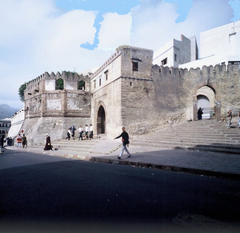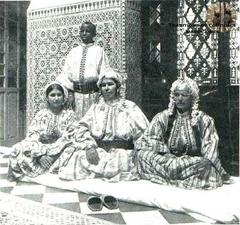
Bab El Okla Tétouan: Visiting Hours, Tickets, and Visitor Guide
Date: 14/06/2025
Introduction
Bab El Okla is an iconic gateway into the UNESCO-listed medina of Tétouan, Morocco. Renowned for its Andalusian-Moroccan architecture and rich heritage, this historic site welcomes thousands of visitors each year, serving not only as a physical entrance but also as a symbol of the city’s multicultural legacy and ongoing community life. This comprehensive guide provides historical context, detailed architectural insights, up-to-date visiting hours and ticket information, accessibility tips, and recommendations for making the most of your visit to Bab El Okla and Tétouan’s medina (UNESCO; Moroccan Ministry of Culture).
Table of Contents
- Introduction
- Historical Overview
- Architecture and Restoration
- Visiting Information (Hours, Tickets, Accessibility)
- Tours and Nearby Attractions
- Cultural Significance
- Events and Community Life
- Practical Tips and FAQs
- Getting to Bab El Okla
- Summary and Recommendations
- Sources
Historical Overview
Origins and Legacy
Bab El Okla, constructed during the late 15th and early 16th centuries, stands as a testament to Tétouan’s rebirth by Andalusian refugees after the Reconquista. Its name, likely derived from the Arabic for “upper” or “high,” reflects its strategic northern position in the medina. The gate’s construction was integral to the city’s defense and economic activity, designed to safeguard the community and regulate trade (UNESCO).
Cultural Evolution
Throughout its history, Bab El Okla has witnessed the ebb and flow of Berber, Andalusian, Arab, and Spanish influences. Its role as a point of entry and social gathering place cemented its importance in Tétouan’s urban and social fabric. The gate’s enduring prominence is reflected in local art, literature, and festivals (Visit Morocco; Cityzeum).
Architecture and Restoration
Structural Features
Bab El Okla exhibits classic Andalusian-Maghrebi design, with robust limestone and brickwork, a prominent horseshoe arch, and crenellated towers. The gate’s walls are up to 2 meters thick, emphasizing its original defensive purpose (Lonely Planet).
Decorative Elements
Despite its defensive origins, the gate’s façade features intricate geometric motifs, low-relief stucco floral patterns, and occasional zellij tilework, all hallmarks of Andalusian-Moroccan artistry. The arch’s spandrels are subtly adorned, reflecting Tétouan’s artistic heritage.
Restoration Efforts
Major restoration campaigns took place during the Spanish Protectorate (1913–1956) and after the medina’s UNESCO designation in 1997. These projects focused on structural stabilization, masonry repair, and conservation of decorative details, ensuring authenticity and accessibility for future generations (UNESCO; Moroccan Ministry of Culture).
Visiting Information
Bab El Okla Gate
- Opening Hours: Open to the public 24/7; ideal for early morning or late afternoon visits for the best light and fewer crowds (Morocco Pass).
- Entry Fee: Free.
- Accessibility: The area directly around the gate is accessible, but the medina’s cobbled, narrow streets may pose challenges for those with mobility issues. Comfortable walking shoes are recommended.
Musée Bab El Oqla (Ethnographic Museum)
- Address: 68, Rue Skala, Tétouan
- Hours: Monday–Sunday, 10:00–18:00 (closed Tuesdays)
- Admission: 20 MAD (adults), 10 MAD (children over 12), 5 MAD (children under 12). Free entry for students, teachers, and ICOM members on certain days (FNM).
- Accessibility: The museum is accessible from Bab El Okla and offers some facilities for visitors with mobility needs.
Tours and Nearby Attractions
Guided Tours
- Availability: Numerous local agencies and guides offer walking tours starting at Bab El Okla, available in multiple languages.
- Experience: Tours cover the medina’s history, architecture, artisan workshops, and culinary highlights (Cityzeum).
Nearby Highlights
- Royal Artisan School (Dar Sanaa): Demonstrations and workshops on traditional crafts.
- Souks and Bazaars: Explore lively markets for textiles, ceramics, and local foods (Visit and Do).
- Royal Palace: Viewable from Place Hassan II.
- Mellah District: Historic Jewish quarter (Journeys Junkie).
- Feddan Park: Relax with views of the medina and Rif Mountains (Away With The Steiners).
Cultural Significance
Bab El Okla serves as a living symbol of Tétouan’s Andalusian roots and resilience. It is featured in local celebrations, art, and literature, and remains a gathering point for both residents and visitors. The gate is also central to community events such as the Tétouan International Mediterranean Film Festival and local artisan fairs, fostering intercultural dialogue and creative exchange (Friendly Morocco).
Events and Community Life
Ethnographic Museum
The adjacent museum, housed in the former fortress, showcases traditional costumes, wedding artifacts, and displays on Tétouan’s urban and artisanal history. It hosts educational workshops and cultural events that engage both locals and tourists (FNM).
Festivals
Bab El Okla is often the ceremonial entrance for festivals and processions, including film screenings, music performances, and artisan exhibitions (Cityzeum).
Practical Tips and FAQs
Practical Tips
- Dress modestly, especially within the medina and religious sites.
- Always request permission before photographing people.
- Support local artisans by purchasing crafts and sampling traditional foods.
- Use local guides for a richer, more informative experience.
FAQ
Q: What are the opening hours for Bab El Okla and the museum?
A: Bab El Okla is open 24/7; Musée Bab El Oqla is open Monday–Sunday, 10:00–18:00 (closed Tuesdays).
Q: Is there an entrance fee?
A: Bab El Okla is free; museum admission is 20 MAD for adults (with discounts/free entry on select days).
Q: Are guided tours available?
A: Yes, local guides offer walking tours from Bab El Okla.
Q: Is the area accessible for people with disabilities?
A: The gate area is relatively accessible, but the medina’s streets can be uneven.
Q: What cultural events take place near Bab El Okla?
A: Annual festivals, film screenings, and artisan fairs are held in and around the gate.
Getting to Bab El Okla
- By Air: Sania Ramel Airport (6 km from Tétouan); Tangier’s Ibn Battuta Airport (65 km) (Morocco Guide).
- By Bus/Car: Regular routes from Tangier and Chefchaouen; parking near Avenue Hassan II (Away With The Steiners).
- By Train: Nearest station is Tangier, with onward travel by bus or taxi to Tétouan (Morocco Guide).
Summary and Recommendations
Bab El Okla is a living testament to Tétouan’s heritage, blending centuries-old architecture, vibrant community life, and a welcoming atmosphere for visitors. Free access, convenient location, and the proximity of museums, markets, and artisan workshops make it an essential stop for travelers. To ensure a memorable visit, plan during spring or autumn for mild weather, start your day early to enjoy the medina’s tranquil ambiance, and immerse yourself in local culture through guided tours and artisan encounters (Lonely Planet; Morocco Pass).
Sources
- UNESCO World Heritage Centre: Medina of Tétouan
- Moroccan Ministry of Culture
- Visit Morocco: Tétouan Travel Guide
- Lonely Planet: Tétouan
- Morocco World News: Tétouan Medina
- Friendly Morocco: Tétouan The Moroccan White Dove
- Cityzeum: Tétouan Tourism
- Morocco Pass: Bab El Okla
- FNM: Musée Bab El Oqla
- Morocco Guide: Getting to Tétouan
- Away With The Steiners: Things to Do in Tétouan
- Visit and Do: The 8 Doors of Tétouan’s Medina
- Journeys Junkie: Places to Visit in Tétouan
- Trip101: Things to Do in Tétouan
- Moroccan Corridor: Bab El Okla Blog
- Morocco Travel Blog: The 7 Gates of Tétouan
- Wikipedia: Musée Bab El Oqla
- Wikivoyage: Tétouan

